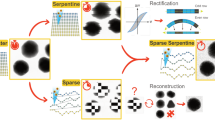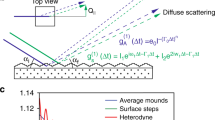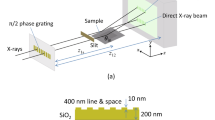Abstract
FOR thin films to be of use, in microelectronics, for example, they must be deposited on bulk substrates. Little is known, however, of the nucleation and structure of very thin films deposited in this way, because the usual methods of study, electron diffraction or microscopy in transmission are not applicable. If the film is polycrystalline and thinner than 100 Å, reflexion electron diffraction can provide crystallographic information; if the film is a single crystal film then low energy electron diffraction is also possible. To study the film in the early stages of formation it must be deposited inside the diffraction camera. Rather few in situ studies by reflexion electron diffraction have been reported1,2, perhaps because conventional reflexion cameras suffer severe disadvantages compared with transmission cameras. The chief disadvantages are that (a) large numbers of secondary and loss electrons are produced which obscure the elastically scattered electrons carrying the erystallographic information; the total intensity of the loss electrons usually exceeds that of the elastically diffracted ones; (b) the effects of contamination are troublesome unless partial pressures of contaminant gases are below 5 × 10−9 torr; (c) the intensities are greatly affected by the surface condition of the specimen and by small changes of the angle of incidence of the electron beam.
This is a preview of subscription content, access via your institution
Access options
Subscribe to this journal
Receive 51 print issues and online access
$199.00 per year
only $3.90 per issue
Buy this article
- Purchase on Springer Link
- Instant access to full article PDF
Prices may be subject to local taxes which are calculated during checkout
Similar content being viewed by others
References
Pashley, D. W., Adv. Phys., 5, 173 (1956).
Pashley, D. W., Adv. Phys., 14, 327 (1965).
Dove, D. B., Grigson, C. W. B., and Stilwell, G. R., Nature, 204, 173 (1964).
Grigson, C. W. B., and Dove, D. B., J. Vac. Sci. Tech., 3, 120 (1966).
Tompsett, M. F., and Grigson, C. W. B., Nature, 206, 923 (1965).
Tompsett, M. F., and Grigson, C. W. B., J. Sci. Instrum., 43, 430 (1966).
Grigson, C. W. B., Nature, 213, 277 (1967).
Author information
Authors and Affiliations
Rights and permissions
About this article
Cite this article
TILLETT, P., GRIGSON, C. Reflexion Scanning Electron Diffraction from Growing Films. Nature 214, 77–78 (1967). https://doi.org/10.1038/214077a0
Received:
Issue Date:
DOI: https://doi.org/10.1038/214077a0
Comments
By submitting a comment you agree to abide by our Terms and Community Guidelines. If you find something abusive or that does not comply with our terms or guidelines please flag it as inappropriate.



